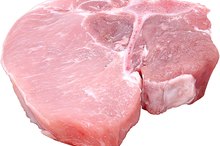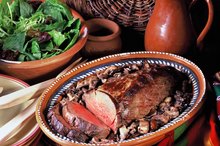Does Pork Make You Sleepy?
Pork is a common source of protein in the United States. It is frequently used in breakfast items such as omelets, quiches and breakfast sandwiches and is also served in main entrees, stews and side dishes. Pork sausage is commonly used in Tex-Mex style chili and is used as a breakfast side dish in link and patty form. Although pork is a rich source of protein, it can also cause feelings of fatigue and sleepiness.
Tryptophan
Pork contains tryptophan, an amino acid that your body uses to manufacture niacin and serotonin. A 4-oz. serving of ground pork contains 0.242 g of tryptophan, and a 3-oz. pork chop contains about 0.33 g of this amino acid, according to the U.S. Department of Agriculture National Nutrient Database 3. Serotonin is a neurotransmitter chemical that has a calming effect on the brain and central nervous system. An elevation in serotonin level may trigger feelings of sleepiness.
- Pork contains tryptophan, an amino acid that your body uses to manufacture niacin and serotonin.
Digestion
Stomach Cramps & Fatty Pork
Learn More
Pork requires more extensive digestion than other sources of protein such as legumes, seeds, nuts and soy products. The digestion process requires an elevated concentration of blood to your digestive system, which pulls blood away from your organs and muscle tissues, according to certified nutritional consultant Phyllis Balch, author of "Prescription for Nutritional Healing." This can lower the availability of nutrients and oxygen to your brain and other organs, which can produce fatigue and sleepiness 1.
Saturated Fats
Red meats such as pork are high in saturated fats -- a 4-oz. serving of ground pork contains about 8.893 g of saturated fats, and a 3-oz. pork chop contains about 2.448 g, according to the USDA National Nutrient Database 3. Saturated fats can contribute to fatty blockages in your arteries and blood vessels, according to Balch. Fatty blockages can restrict blood flow through your circulatory system, which can deprive your organs and muscle tissues of oxygen and nutrients, causing fatigue and sleepiness.
- Red meats such as pork are high in saturated fats -- a 4-oz.
- Saturated fats can contribute to fatty blockages in your arteries and blood vessels, according to Balch.
Alternatives
Zopiclone Side Effects
Learn More
Obtain lean protein from sources such as lentils, chickpeas, soy products, seeds and nuts instead of pork. Tofu contains a similar amount of tryptophan -- about 0.31 g per 1/2 cup serving -- but is lower in saturated fats than pork. Nuts, seeds and legumes do not contain significant amounts of tryptophan, and the fats in these foods are primarily unsaturated fats, which may help reduce fatty deposits in your circulatory system, according to Balch. These foods also contain dietary fiber, which aids in proper digestion, reducing sleepiness and fatigue after eating.
- Obtain lean protein from sources such as lentils, chickpeas, soy products, seeds and nuts instead of pork.
- Nuts, seeds and legumes do not contain significant amounts of tryptophan, and the fats in these foods are primarily unsaturated fats, which may help reduce fatty deposits in your circulatory system, according to Balch.
Related Articles
References
- "Prescription for Nutritional Healing"; Phyllis A. Balch, C.N.C., et al.; 2010
- University of Maryland Medical Center: Tryptophan; Patrika Tsai, M.D., M.P.H.; February 2008
- USDA: National Nutrient Database
- Pork, fresh, loin, tenderloin, separable lean only, cooked, roasted. FoodData Central. U.S. Department of Agriculture. Published April 1, 2019.
- Pork steak or cutlet, broiled or baked, lean only eaten. FoodData Central. U.S. Department of Agriculture. Published April 1, 2019.
- Pork, fresh, ground, cooked. FoodData Central. U.S. Department of Agriculture. Published April 1, 2019.
- Pork chop, broiled or baked, lean and fat eaten. FoodData Central. U.S. Department of Agriculture. Published April 1, 2019.
- Pork chop, broiled or baked, lean only eaten. FoodData Central. U.S. Department of Agriculture. Published April 4, 2019.
- Pork chop, breaded or floured, fried, lean and fat eaten. FoodData Central. U.S. Department of Agriculture. Published April 4, 2019.
- Pork sausage. FoodData Central. U.S. Department of Agriculture. Published April 4, 2019.
- Pork bacon, smoked or cured, cooked. FoodData Central. U.S. Department of Agriculture. Published April 4, 2019.
- Pulled pork. FoodData Central. U.S. Department of Agriculture. Published April 4, 2019.
- Spam, Classic Spam. FoodData Central. U.S. Department of Agriculture. Published April 4, 2019.
- Naseeb MA, Volpe SL. Protein and exercise in the prevention of sarcopenia and aging. Nutr Res. 2017;40:1-20. doi:10.1016/j.nutres.2017.01.001
- American College of Allergy, Asthma and Immunology. Meat allergy. Updated May 8, 2019.
- Turesky RJ. Mechanistic evidence for red meat and processed meat intake and cancer risk: A follow-up on the International Agency for Research on Cancer Evaluation of 2015. Chimia (Aarau). 2018;72(10):718-724. doi:10.2533/chimia.2018.718
- Djurković-Djaković O, Bobić B, Nikolić A, Klun I, Dupouy-Camet J. Pork as a source of human parasitic infection. Clin Microbiol Infect. 2013;19(7):586-94. doi:10.1111/1469-0691.12162
Writer Bio
Owen Pearson is a freelance writer who began writing professionally in 2001, focusing on nutritional and health topics. After selling abstract art online for five years, Pearson published a nonfiction book detailing the process of building a successful online art business. Pearson obtained a bachelor's degree in art from the University of Rio Grande in 1997.









